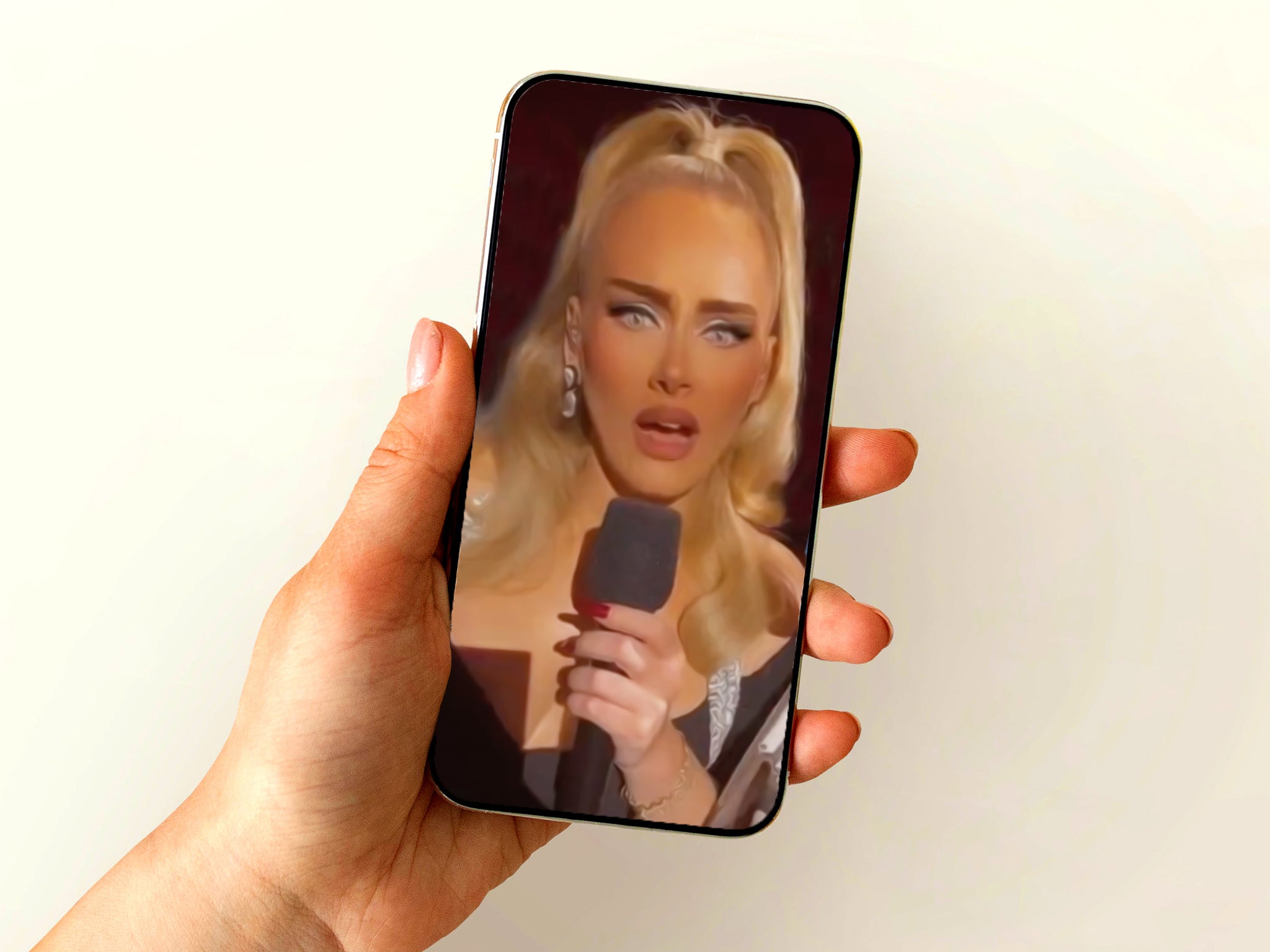Adele’s (fake) face said it all: Why we need to talk about non-consensual beauty filtering
Adele went viral this week after being spooked by a filtered version of her face as seen on a fan’s phone. Everything looked different, from the colour of her skin to the size of her lips. She isn’t alone in experiencing a drive-by filtering, writes Ellie Muir, and we’re all suffering the consequences


Your support helps us to tell the story
From reproductive rights to climate change to Big Tech, The Independent is on the ground when the story is developing. Whether it's investigating the financials of Elon Musk's pro-Trump PAC or producing our latest documentary, 'The A Word', which shines a light on the American women fighting for reproductive rights, we know how important it is to parse out the facts from the messaging.
At such a critical moment in US history, we need reporters on the ground. Your donation allows us to keep sending journalists to speak to both sides of the story.
The Independent is trusted by Americans across the entire political spectrum. And unlike many other quality news outlets, we choose not to lock Americans out of our reporting and analysis with paywalls. We believe quality journalism should be available to everyone, paid for by those who can afford it.
Your support makes all the difference.At her residency in Las Vegas last Sunday, Adele posed for a selfie with a fan. There was nothing weird about it. Until she saw what the fan’s phone camera settings had done to her face. It wasn’t Adele as we know her. This Adele, staring back at the singer from the phone, had orange-tinged skin and a chiseled jaw. Her lips were comically large, her eyes bright blue. “Oh my god, what have you done to my face?” Adele exclaimed. “We don’t look like that, darling!” She’d been filtered against her will.
When Instagram was first launched in 2010, its two image-altering filters were named “Miami” and “Sepia” – they changed the colours of the images put through their system, if not the actual subjects themselves. Now, however, filters have taken on a different function, with built-in technology able to warp individual facial features at the press of a button. “Coloured eyes”, a popular filter, airbrushes the subject’s skin, gives them plumper lips and rosier cheeks. Your eye colour could be changed to an aquamarine blue or a bright violet. Most popular filters raise your cheekbones, as if you’ve had dermal filler injected into your face. What’s more, TikTok’s “skinny filter” can make your body look slimmer. Instagram’s “perfect face” (yes, really) adjusts facial features to be abnormally symmetrical.
Like Adele, my face has also been filtered against my will. Last summer, a friend asked to take a picture together at a house party. I obliged. In the photo, my cheeks looked as though an elf with tiny hands had pinched them and pulled them up vertically. My nose had been turned narrow and shiny. It was overwhelming. I felt as if my face had been morphed into a Kim Kardashian-meets-Bella Hadid sexy baby.
It’s often uncomfortable to be on the receiving end of a forced filtering, even when the reasons behind image editing are well-known. “Comparing ourselves to idealistic images has happened throughout history,” says Phillippa Diedrichs, a psychologist at the Centre of Appearance Research at the University of West England. “Over the past century, we began comparing ourselves to images in the media – celebrities, models, film stars. What’s different now is we’re also comparing ourselves to versions of ourselves that are digitally distorted.”
The food and drink digital creator Sabina (@girlvsglobe), drew praise on TikTok in August after deliberately using a filter on her video that airbrushed her entire complexion. “I’m getting so fed up with filters like this one,” she admitted to her followers. “It looks great but watch what happens when I remove the retouch [effect].” In the video, she taps the screen and switches off the filter, revealing her natural complexion. “I don’t look bad,” she says, “but my brain has become so accustomed to seeing my face morphed into this plastic, smoothened version of myself.”
A study conducted by City, University of London, found that 90 per cent of women polled have used filters because they felt pressure to look a certain way on social media. Research also found that filters are being most commonly used to brighten and even out skin tone, whiten teeth and digitally remove any excess flesh. It’s so rife that it’s having an effect on younger generations, too. According to the annual Girl Guiding survey, 77 per cent of girls aged 11 to 16 say they don’t feel pretty enough.
According to Diedrichs’ recent research with the Dove Self-Esteem Project, 80 per cent of girls will have used a filter by the time they hit their 13th birthday. She adds that there are many things wrong with this, but notably the messages that filters convey about beauty. “[They] conform to today’s beauty standards, which are inherently Eurocentric, and also unachievable for most people without having a surgical intervention,” she says. “There are some experimental filters out there that are a source of artistic and creative expression. But it becomes problematic when the filters are designed in a way to perpetuate and conform to narrower beauty standards, which are related to appearance based on stereotypes and gender norms.”
@girlvsglobe anyone else hate beauty filters? 🫣 my self esteem takes such a battering every time I compare my real skin texture to my airbrushed, retouched, filtered face on here! would love to hear your thoughts on social media filters - are they toxic or dangerous, or harmless? ❤️ #beautyfiltersaretoxic #filtersaredangerous #realskintexture
♬ Hold Me Closer - Elton John & Britney Spears
On top of altering the complete structure of a person’s facial features, many filters are also designed to lighten the skin of those in the picture. Some filters may add a tan to a subject’s face and body, but this is usually an orange tint with a white overcast. “These filters perpetuate much broader appearance-based biases that are [rooted in] racism and colourism, as well as the prejudice that feeds into gender stereotypes,” Diedrich says.
Experts are warning against the use of photo-editing apps like FaceApp, as well as filters, especially for people who have low body confidence. “When people have poor body image, they’re more likely to be at risk for disordered eating, and much more likely to consider invasive cosmetic procedures, which come at medical and financial risk,” Diedrichs says. “They’re more likely to experience low self esteem, anxiety and depression.”
It also means that putting a filter on someone else’s picture isn’t automatically as harmless as you might think. Filters may not be directly linked to anxiety or body dysmorphia, but they are part of a broader beauty culture helping fuel a self-esteem crisis. We know that already, though. When Adele told her fan that the women staring back at them on her fan’s phone didn’t look like them in reality, her fan quietly nodded in recognition. “I know,” she can be heard saying. But that’s what filters do: they make you hyper-aware of your own face, and hyper-aware of what apparently needs to change about it. And why would you want to inflict that on someone else, too?



Join our commenting forum
Join thought-provoking conversations, follow other Independent readers and see their replies
Comments